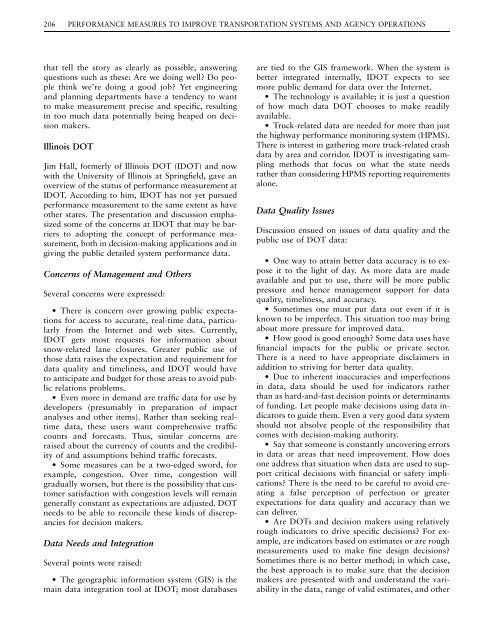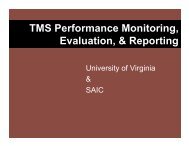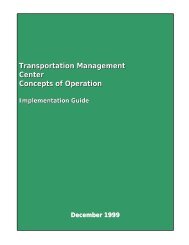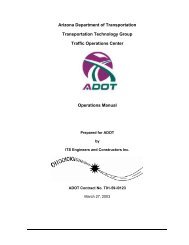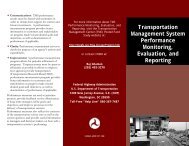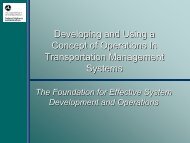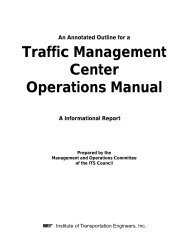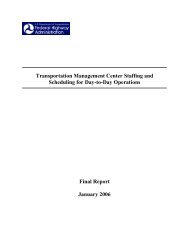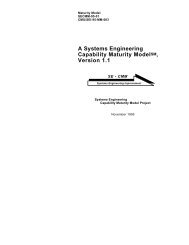Conference Proceedings 26 - Transportation Research Board
Conference Proceedings 26 - Transportation Research Board
Conference Proceedings 26 - Transportation Research Board
- No tags were found...
You also want an ePaper? Increase the reach of your titles
YUMPU automatically turns print PDFs into web optimized ePapers that Google loves.
206 PERFORMANCE MEASURES TO IMPROVE TRANSPORTATION SYSTEMS AND AGENCY OPERATIONSthat tell the story as clearly as possible, answeringquestions such as these: Are we doing well? Do peoplethink we’re doing a good job? Yet engineeringand planning departments have a tendency to wantto make measurement precise and specific, resultingin too much data potentially being heaped on decisionmakers.Illinois DOTJim Hall, formerly of Illinois DOT (IDOT) and nowwith the University of Illinois at Springfield, gave anoverview of the status of performance measurement atIDOT. According to him, IDOT has not yet pursuedperformance measurement to the same extent as haveother states. The presentation and discussion emphasizedsome of the concerns at IDOT that may be barriersto adopting the concept of performance measurement,both in decision-making applications and ingiving the public detailed system performance data.Concerns of Management and OthersSeveral concerns were expressed:• There is concern over growing public expectationsfor access to accurate, real-time data, particularlyfrom the Internet and web sites. Currently,IDOT gets most requests for information aboutsnow-related lane closures. Greater public use ofthose data raises the expectation and requirement fordata quality and timeliness, and IDOT would haveto anticipate and budget for those areas to avoid publicrelations problems.• Even more in demand are traffic data for use bydevelopers (presumably in preparation of impactanalyses and other items). Rather than seeking realtimedata, these users want comprehensive trafficcounts and forecasts. Thus, similar concerns areraised about the currency of counts and the credibilityof and assumptions behind traffic forecasts.• Some measures can be a two-edged sword, forexample, congestion. Over time, congestion willgradually worsen, but there is the possibility that customersatisfaction with congestion levels will remaingenerally constant as expectations are adjusted. DOTneeds to be able to reconcile these kinds of discrepanciesfor decision makers.Data Needs and IntegrationSeveral points were raised:• The geographic information system (GIS) is themain data integration tool at IDOT; most databasesare tied to the GIS framework. When the system isbetter integrated internally, IDOT expects to seemore public demand for data over the Internet.• The technology is available; it is just a questionof how much data DOT chooses to make readilyavailable.• Truck-related data are needed for more than justthe highway performance monitoring system (HPMS).There is interest in gathering more truck-related crashdata by area and corridor. IDOT is investigating samplingmethods that focus on what the state needsrather than considering HPMS reporting requirementsalone.Data Quality IssuesDiscussion ensued on issues of data quality and thepublic use of DOT data:• One way to attain better data accuracy is to exposeit to the light of day. As more data are madeavailable and put to use, there will be more publicpressure and hence management support for dataquality, timeliness, and accuracy.• Sometimes one must put data out even if it isknown to be imperfect. This situation too may bringabout more pressure for improved data.• How good is good enough? Some data uses havefinancial impacts for the public or private sector.There is a need to have appropriate disclaimers inaddition to striving for better data quality.• Due to inherent inaccuracies and imperfectionsin data, data should be used for indicators ratherthan as hard-and-fast decision points or determinantsof funding. Let people make decisions using data indicatorsto guide them. Even a very good data systemshould not absolve people of the responsibility thatcomes with decision-making authority.• Say that someone is constantly uncovering errorsin data or areas that need improvement. How doesone address that situation when data are used to supportcritical decisions with financial or safety implications?There is the need to be careful to avoid creatinga false perception of perfection or greaterexpectations for data quality and accuracy than wecan deliver.• Are DOTs and decision makers using relativelyrough indicators to drive specific decisions? For example,are indicators based on estimates or are roughmeasurements used to make fine design decisions?Sometimes there is no better method; in which case,the best approach is to make sure that the decisionmakers are presented with and understand the variabilityin the data, range of valid estimates, and other


